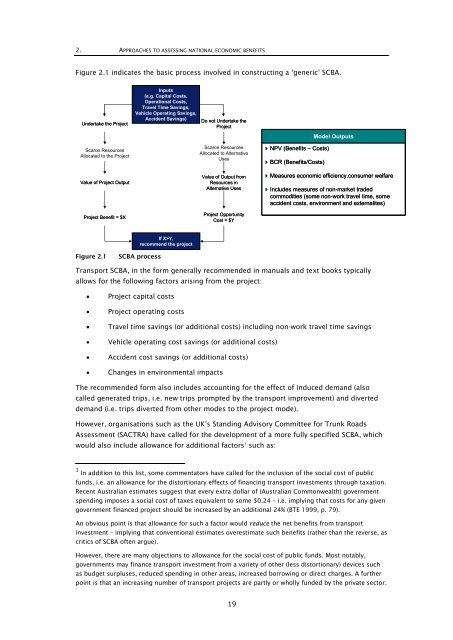Research 350 - NZ Transport Agency
Research 350 - NZ Transport Agency
Research 350 - NZ Transport Agency
Create successful ePaper yourself
Turn your PDF publications into a flip-book with our unique Google optimized e-Paper software.
2. APPROACHES TO ASSESSING NATIONAL ECONOMIC BENEFITS<br />
Figure 2.1 indicates the basic process involved in constructing a ‘generic’ SCBA.<br />
Undertake the Project<br />
Scarce Resources<br />
Allocated to the Project<br />
Value of Project Output<br />
Project Benefit = $X<br />
Inputs<br />
(e.g. Capital Costs,<br />
Operational Costs,<br />
Travel Time Savings,<br />
Vehicle Operating Savings,<br />
Accident Savings)<br />
Do not Undertake the<br />
Project<br />
Scarce Resources<br />
Allocated to Alternative<br />
Uses<br />
Value of Output from<br />
Resources in<br />
Alternative Uses<br />
Project Opportunity<br />
Cost = $Y<br />
Model Outputs<br />
NPV (Benefits – Costs)<br />
BCR (Benefits/Costs)<br />
Measures economic efficiency.consumer welfare<br />
Includes measures of non-market traded<br />
commodities (some non-work travel time, some<br />
accident costs, environment and externalites)<br />
If X>Y,<br />
recommend the project<br />
Figure 2.1<br />
SCBA process<br />
<strong>Transport</strong> SCBA, in the form generally recommended in manuals and text books typically<br />
allows for the following factors arising from the project:<br />
• Project capital costs<br />
• Project operating costs<br />
• Travel time savings (or additional costs) including non-work travel time savings<br />
• Vehicle operating cost savings (or additional costs)<br />
• Accident cost savings (or additional costs)<br />
• Changes in environmental impacts<br />
The recommended form also includes accounting for the effect of induced demand (also<br />
called generated trips, i.e. new trips prompted by the transport improvement) and diverted<br />
demand (i.e. trips diverted from other modes to the project mode).<br />
However, organisations such as the UK’s Standing Advisory Committee for Trunk Roads<br />
Assessment (SACTRA) have called for the development of a more fully specified SCBA, which<br />
would also include allowance for additional factors 1 such as:<br />
1 In addition to this list, some commentators have called for the inclusion of the social cost of public<br />
funds, i.e. an allowance for the distortionary effects of financing transport investments through taxation.<br />
Recent Australian estimates suggest that every extra dollar of (Australian Commonwealth) government<br />
spending imposes a social cost of taxes equivalent to some $0.24 – i.e. implying that costs for any given<br />
government financed project should be increased by an additional 24% (BTE 1999, p. 79).<br />
An obvious point is that allowance for such a factor would reduce the net benefits from transport<br />
investment – implying that conventional estimates overestimate such benefits (rather than the reverse, as<br />
critics of SCBA often argue).<br />
However, there are many objections to allowance for the social cost of public funds. Most notably,<br />
governments may finance transport investment from a variety of other (less distortionary) devices such<br />
as budget surpluses, reduced spending in other areas, increased borrowing or direct charges. A further<br />
point is that an increasing number of transport projects are partly or wholly funded by the private sector.<br />
19
















